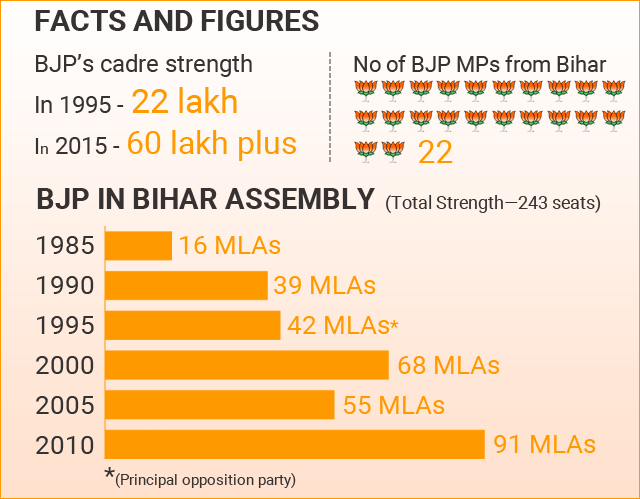Bihar base consolidated, BJP now aims for the finishing touch
There is no denying that the BJP has become a formidable political force in Bihar. In the outgoing assembly, it is the second-largest party with 88 MLAs — next only to former partner JD(U)’s 115.
At the height of the Ayodhya agitation, when then chief minister Lalu Prasad stopped BJP stalwart LK Advani’s rath yatra in October 1990, anger and dissent engulfed the party’s 10-year-old Bihar unit.
Many in the local unit felt the BJP leadership had failed to capitalise on the sympathy wave. But that failure gave the party think tank a chance to reorient its strategy, one step at a time.
From 39 MLAs in 1990, it upstaged the Congress as the main opposition party in the assembly with 42 seats in 1995. A year on, Sushil Kumar Modi emerged as leader of the opposition amidst the fodder and bitumen scams that chipped away quite a chunk of Lalu Prasad’s unchallenged clout in the state.
“The Congress was never an effective opposition but the BJP from 1995-2000 showed what an opposition party meant,” says Modi, who went on to become deputy chief minister in alliance government led by Nitish Kumar, when the JD(U) was a part of the NDA.
But 2000 brought the wind back in Prasad’s sails as the BJP lost most of its MLAs to the new state of Jharkhand. His Muslim and Yadav (M-Y) combination and continued emphasis on Mandal politics cast its shadow on the BJP, clouding its image as a party of upper castes and merchants.
Read:
The party regrouped again. It took to social engineering, laced with development and hope. “There was a realisation that without making inroads into the backward castes, the party cannot move forward,” says Modi.
Ganga Prasad, a veteran Jan Sangh leader and a member of the legislative council (MLC) or upper house of the assembly, agrees. “This was but natural in Bihar politics. We worked on the basis of its merit and tried to break the misconception that the BJP was a party of Brahmins and Baniyas.”
The party pushed social engineering to another level, reserving 25% of posts in its 400-member strong state working committee for OBCs, 16% for SC, 33% for women. Today, the BJP has cells for almost all sections of society — extremely backward caste (EBC), Mahadalits, SC, ST, minority, et al.
The party’s cadre strength stands at more than 60 lakh now, against 22 lakh a decade ago.
“The party took pains to ensure that no caste or community was left out. It is the result of this meticulous planning that we have representations in the assembly from Chandravanshi samaj, Nonia samaj and Nishad…to name a few,” says Modi.
The BJP also targeted the numerically strong Dalits and OBCs by honouring cult figures of these communities, such as observing birth anniversaries of Dalit hero Baba Chuhar Mal and Ashoka the Great, the Mauryan emperor who was from the Kushwaha community. Kushwahas are second only to the Yadavs among the OBCs whose votes are considered crucial in elections.
Also, it didn’t forget the anniversaries of legendary poet Ramdhari Singh Dinkar; former chief minister Karpoori Thakur; Sant Ravidas, a social reformer with significant following among Dalits; Maharana Pratap, the 16th-century ruler of Mewar; and Kunwar Singh, the 1857 freedom struggle hero.

The result was stupendous — of 38 reserved constituencies in the 243-member assembly, 19 are represented by the BJP. Dalits never voted for the BJP in such large numbers anywhere in the Hindi heartland, let alone Bihar, even at the height of the Ram Janmabhoomi movement.
Despite all this, the party continues to face allegations of stoking communal tensions with an eye on consolidating its Hindu vote bank. The party denies all such charges, but with a vote share of nearly 42% in 2010, there is no denying that it has become a formidable political force in Bihar. In the outgoing assembly, it is the second-largest party with 88 MLAs — next only to former partner JD(U)’s 115.
Buoyed by its rapid growth in the state, Modi says the BJP is now a strong claimant for running the government in Bihar. Its rivals, however, would want the claim to be proven wrong in the upcoming polls.
Read:





